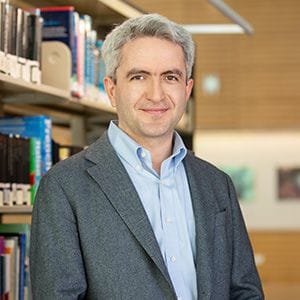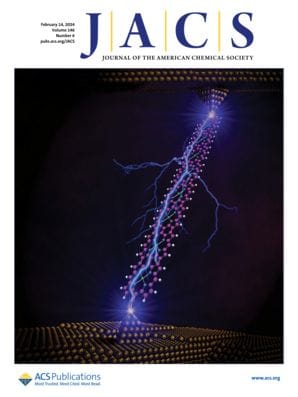In this interview, Prof. Yavuz discusses his group's current work in nanoscale materials and shares his experience with—and views on—open access.

As part of an ongoing series here on ACS Axial, we’re interviewing authors and librarians from around the world to find out more about their research, their published work, and the impact that open science is having on a changing landscape of research communication. This time, we're speaking with Prof. Cafer T. Yavuz, Professor of Chemistry at King Abdullah University of Science and Technology, Saudi Arabia, and Principal Investigator of Yavuzlab.
That's how it should be, I think—straightforward without needing to submit paperwork to make an article open access.

Good afternoon, Professor Yavuz. Could you tell us about your research group’s current focus?
We are a materials chemistry lab, so we produce materials for certain applications. Our interest is mainly in carbon dioxide capture and conversion, but we also target water treatment applications. Our third area of focus is catalysis, because all of these applications require chemical conversion at some point.
In terms of the materials aspect, we work on nanoscale materials. Usually these are either inorganic nanoparticles or what people are calling nanoporous materials - though these are effectively porous materials with nanoscale pores.
Could you describe the work covered in your recent publication, for someone who isn't familiar with the area?
Covalent organic frameworks are a class of porous materials. They're polymeric, sponge-like materials, almost like Styrofoam, but in nanoscale form. They're fascinating new materials that have been developed over the past two decades or so. In our paper we reviewed the progress on covalent organic frameworks which are designed to be used in water treatment applications.
When you produce a review article, you have to give a balanced overview of the current state of research, and so we highlighted the significant potential of covalent organic frameworks where the pore confinement - which means that the pores are small enough to selectively capture molecules or compounds rather than capture everything - is an advantage in materials where you can control the size of the pores. There are also some disadvantages. For example, while these are really nice initial discoveries, it's not clear how large a scale you can produce them, and how you can apply them under certain realistic conditions. Water treatment requires a lot of filtration, a lot of pumping, and a lot of pH swings, all of which mean you will need very good control over the stability of the structure. These are the weak points that need to be improved upon.
That's why we chose to write this Perspective: to summarize the strengths and areas that still need improvement, so that researchers can follow on and so that some new students get excited about this research area and choose to pursue it.

Covalent Organic Framework Membranes and Water Treatment
DOI: 10.1021/jacs.3c10832
Your article was published in the Journal of the American Chemical Society (JACS)—how was the experience?
I believe JACS is a good venue for our papers, which is why we routinely submit and publish our work there. I've found that it's always a smooth process to publish with ACS, and as a high impact journal, I'm happy with the rigor that JACS offers.
What kind of impact do you think it's had since publication?
Last time I checked, the paper had already been cited quite a lot. I find that one way to find out whether a paper is well received is that you start getting review requests for other papers in that field, and I've been getting a lot more requests to review papers about water treatment, which means that people are recognizing our work in this area and recommending me as a reviewer.
There are measures like altmetrics that can tell you how much a paper has been read and discussed online, but you don't always know the context.
Your article was published open access as part of your institution’s read and publish agreement with ACS. How did you discover this was available?
I believe it was automatic. We were informed a couple years back by our institution about an agreement being available. Once we had submitted to JACS and I was dealing with the acceptance process, there was a very clear message telling me that we had an agreement and asking me if I would like to publish open access. From then on it was rather smooth. That's how it should be, I think—straightforward without needing to submit paperwork to make an article open access. When it's presented that way, I think open access is a no-brainer: who wouldn't want their paper to be open access?
What are your thoughts on the concept of open access?
I strongly support open access, which is one reason why I joined the editorial board of the Beilstein Journal of Nanotechnology which is a diamond open access journal—all the costs are sponsored by the Beilstein Foundation. I believe that's the ideal method of open access where the research funders should support these efforts, because article publishing charges (APCs) shift the financial burden to researchers, which affects the funds available to do research.
Thankfully, I'm at an institution where we are well funded, so I do not have a problem of publishing open access, but I do feel concerned when I see high APCs to publish open access that could otherwise fund a few graduate students for a month. I think there should be caps on APCs so they do not go beyond the equivalent of a monthly graduate student salary in that country. APCs are challenging for researchers in low-income countries—publishes often discount or waive those fees, but there are still cases where a young researcher who doesn't have much funding but who has produced a more exciting work should get a cheaper APC than a very senior professor who has lots of funding available to them.
What are your thoughts on open science concepts such as preprints, transparent peer review, and open data?
I also support open science, but in my field, preprints are not used very much because we work on materials which have to be patented because our funders or universities require it. Sometimes, the patenting process takes a very long time, and during that period we cannot make any public disclosure about the work. In those cases, a preprint isn’t a part of our publishing process because as soon as I'm done with patent application, I have a finished paper that's ready to submit. I don't remember even posting a preprint other than when publishing in a few journals who offer it as a standard part of the process—they ask if they can deposit your submitted manuscript as a preprint during the publication process. I believe something like this would be good for all journals to do. Beilstein does this, which is, I think, incredibly helpful because you submit a paper and then you can opt to be listed as a preprint on their site. It's an automatic process, and your preprint stays live whether or not the final version is published in a Beilstein journal, which gives you some exposure. And Beilstein is a low volume publisher—I think others like ACS, RSC, or Wiley should start doing this too, so that even if an article is rejected, a preprint exists, and people can read it. I think that's something that the open science movement has to think about.
What do you think are the most important recent developments in open science and open access?
I have a different view than most colleagues in that I believe the more journals, the better. Some researchers don't like this idea, but it's all about supply and demand: as long as there is a demand for places to publish and read science, there can be a supply of journals.
So I believe new open access journals are adding new venues for publication, because financing is no longer a big issue: anybody can come and start a journal and start charging for publication. That's good, because that's what you want—a lot of outlets for people to make use of, combined with social media to build an audience. That's why social media is so good, because any ordinary person can get a lot of views, which we haven't really seen yet in how science is disseminated. Of course, there are challenges along with that, because you need to check the claims that scientists are making, but that's the role of peer review.
The question then becomes about quality. New journals are being started every day, all over the world, and the market kind of polices itself because the lower-quality journals will close down and the more successful ones that people value highly will continue. I think it's a very positive thing that anybody in any part of the world who has access to the internet can launch an open access journal and start charging article publishing charges, because it creates healthy competition.
Where do you see open access in 10 years' time?
In 10 years, I don't think there will be maturity at all, because the entry point is so low that people will keep producing new journals. There's a limit to how many unique journal names you can create, of course, but I don't think the volume of articles will saturate those journals. I think that the number of articles will grow exponentially bigger and bigger as long as there's significant scientific funding globally—and there's no question that science and technology is at the top of agenda of every government now because they know that's how they can make their economy sustainable, and their investment in research helps us as scientists to do the right thing. We conduct research into sustainability, and we try to help humanity and the survival of our species. Certainly, Saudi Arabia is very flush in funding for science and technology, so here we have a good outlook for the next 10 years that Saudi scientists will continue generating more publications, and a lot of them will be open access.
I believe at some point that giant organizations like Google, Amazon, or Apple will come into this market to disrupt it—even if they're not currently in the publication industry—which will be a major force that will move things around. For example, what I expect Google to do is some kind of crowdsourced peer reviewing system, or maybe preprints that are semi-peer reviewed. But since it's Google, the brand has a significant weight, and they can easily handle the big data around peer review management which will help them identify how much authority someone has to review a paper. The better their reviews, the higher "rank" the paper will be, and then people will be able to prioritize their reading based on that rank. I think that's the future of open access, if you ask me: a giant like Google steps in and sweeps it all up, incentivizes authors and reviewers, then the matter of submission and reviewing will be measured in a day or hours, because highly qualified scientists from around the world will be chipping in because Google will make it incentivized.
What do you think you'd be doing if you weren't a researcher?
Certainly not politics! (laughs)
I'm not sure, because I think I've known since middle school that I wanted to be a scientist. I enjoy management, though, so if I was working in a different industry, I'd probably be managing companies or NGOs where you actually go out and help people. I think those are something I would have liked.
Way back, I applied for the R&D branch of Google, and at the time my brother was wondering why I, as a chemist, would be applying for a role there. And I pointed out that they are a big company with lots of interests, including energy projects—which is something they're working a lot on now.
Check out the other interviews in this series:
Ian Cousins, Stockholm University
Hongxia Duan, TU Eindhoven
Vojtěch Vaněček, Institute of Physics, Czech Academy of Sciences
Louise Otting, TU Delft
Kristine Horvat, University of New Haven
David W. McCamant, University of Rochester
Fernando Sartillo Piscil, Benemérita Universidad Autónoma de Puebla
Lillian Chong, University of Pittsburgh
Sue Cardinal, University of Rochester
Rubén Mendoza-Cruz, Universidad Nacional Autónoma de México
Alison Bradley, Partnership for Academic Library Collaboration and Innovation
Vesna Srot, Max Planck Institute for Solid State Research
Matt McDowell, Georgia Institute of Technology
Jamie Cripwell, Stellenbosch University